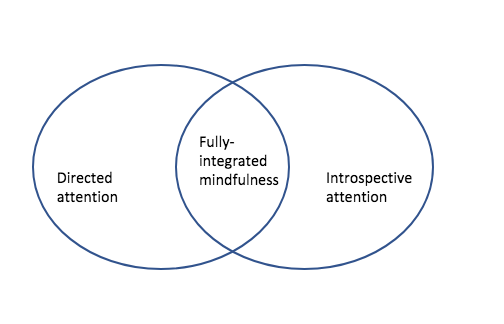What is truly mindful living? Popular culture today associates mindfulness with a narrow set of activities, usually some kind of breathing or guided meditation (often using an app). Its true application however, is deep and far reaching – mindfulness is a way of life. Mindfulness is really about the quality and nature of your attention, not just when doing breathing meditation, but all the time!
To understand how a mindful state might be different, we have to first investigate the nature of attention. Only by understanding attention can we discover how mindfulness is a way of life. Let us begin.
(i) Attention hijacked
Think of the last time you were mesmerised by a movie or by a striking billboard advertisement that made you stop in your tracks. You were probably so struck by what was before you that your attention was hijacked. With this kind of attention, which I am going to refer to as attention-hijacked — the thing, whatever it may be, completely captures our mental awareness. So much so that we lose all sense of our physical selves, wider surroundings and even what we were doing.
Attention-hijacked may be conscious or non-conscious. Meaning that your attention might be hijacked without you intending it, for example, by a snazzy commercial. Or, because you consciously willed it by deciding to see Blade Runner 2049 in 70mm iMAX!
Many gradations
Of course, there are also many gradations in between. Just think of the annoying adverts thrust upon you at the cinema before the long-awaited sequel begins. You consciously intend (if all goes well) being captivated by the movie, but not necessarily by those big-budget car adverts. While attention-hijacked may be conscious or non-conscious, it is almost always passive. Meaning you have to exert minimal mental effort to maintain your attention on the thing. Because your attention has been hijacked and held hostage. If anything, you need mental effort to divert your attention away from it.
It can be subtle
A subtler form of attention-hijacked may arise even in the absence of an immediate external stimulus. How? The mind wanders when it is left unattended, and as it wanders it might latch onto a random thought. Perhaps that moment when you embarrassed yourself a little at the office Christmas party. And, ten minutes later you are re-living the key events of the evening and even the subsequent day at work, when much to your surprise, no one seemed to care. Mind-wandering is then almost like a default mental state when we are not actively engaged in doing something.
Mind-wandering
Left alone, the mind wanders, latches on to a thought, and then our attention is hijacked for a period of time (which may be seconds or several minutes) before it eventually moves onto the next thought. Sometimes, we latch on to things that are important to us that have been at the backs of our minds.
At other times, we may latch on to things that have made random impressions. Like how funny that man on the train looked with his oversized coat yesterday. Whether you are at the cinema or day dreaming on the train, what identifies attention as being hijacked is that you are passive during that experience. Your attention is grabbed and held, with you having to do very little at all.
(ii) Directed Attention
Now, think of a time when you purposefully focused your attention on a task. Perhaps preparing a presentation for work, proof reading a document or doing your taxes. This kind of attention involves self-directed, moment-by-moment mental focus. Different to attention-hijacked, it is then very active. Such directed, task-oriented attention, which I will call directed attention, is what we typically engage in general day-to-day living; in making plans for the future and in our social interactions.
Successfully doing any task, no matter how simple, requires some degree of present moment focus, without which we would not get anywhere. So, directed-attention has a certain quality of being moment-by-moment. Directed attention is also what enables us to maintain our sense of self across time. To create a coherent narrative around our many experiences. The ever-evolving story of I. Rooted in language, directed-attention correlates with activity in the dorsolateral pre-frontal cortex of the brain.
(iii) Introspective Attention – The gateway to mindfulness as a way of life
While being actively self-directed and moment-by-moment in its nature, directed-attention is still missing something. That of in-the-moment awareness of overall self — of physical sensations, feelings and thoughts. Our ability to feel what we are feeling and to know that we are knowing. This type of attention, which I will refer to as introspective attention is about seeing inside ourselves and noticing both body and mind, moment-by-moment.
Interestingly, the little we know about the human brain associates such moment-by-moment self-awareness with activity in a different part of the brain, the medial pre-frontal cortex. So, in addition to differing in the way that we experience them, it appears that directed attention and introspective attention are localised in different areas of the brain as well.
So, is introspective attention the same as a mindful state?
Well, yes and no.
Yes, in the sense that we need introspective attention switched-on in order to be in a mindful state, so that we really do notice both body and mind in the moment. One cannot be truly mindful without introspective awareness. However, it is possible to tone down or even shut-down directed attention as we increase introspective attention.
Mindfulness as a way of life is NOT theoretical
In my mind, this points to one of the shortcomings of overly formal meditation. You know, the sitting under a tree kind, with your legs crossed and your thumb touching your index finger like a yogi from the movies. The danger here is that we can restrict mindfulness to some sort of theoretical exercise that is removed from everyday life.
I am not saying that one should not do such things. Au contraire. It is a great way of getting more in touch with yourself and for developing more self-awareness. Like a practice study. Or simply a way of relaxing and re-charging. All great stuff. But, the real point of such things is to integrate and incorporate it into everyday living. Otherwise, what’s the bloody point!
Altered states are far from mindfulness being part of everyday life
I also worry about those who use meditation regularly to access ‘altered’ states of consciousness. Such experiences can be useful for opening one’s mind to yet unexperienced things. But, if one is constantly chasing these experiences outside of everyday living, it can disengage us from everyday life, when everyday life is the very thing that we ought to fully and wholeheartedly engage in.
(iv) Fully-integrated mindfulness = mindfulness as a way of life
So, what does a more integrated mindful state look like? It is a way of being that involves maintaining introspective attention even when directed attention is switched on, whether you are proof reading a document, chatting to a friend, ruminating over the past or watering the plants. The same is true even when we allow our attention to be hijacked.
You can still be mindful that it has been hijacked and how your body and mind are behaving in the moment. And, as soon you become aware that attention has been hijacked, it is in fact no longer hijacked. Because you enter a mindful state simply by becoming aware!
Meta awareness
So, fully-integrated mindfulness is about always maintaining a kind of meta awareness. Only then can we truly allow mindfulness to become a general way of being and not a theoretical or relaxation exercise. An exercise after which we go back to how we were before we started the exercise. And, fully-integrated mindfulness is a skill that can be practiced, all the time.
As I type these words on the train, for example, I can feel that my directed attention is dominating, totally absorbing every ounce of my focus. I can also feel that I am sitting awkwardly in the seat and how my body feels a bit tense. As I continue to write now, I feel more comfortable. I am more aware of my body, alongside concentrating on the writing. Shit! I just missed my stop. And, so the practice goes on.
Your practice will be unique to you
Awareness of body and my physical environment is something I personally struggle with a lot and something I am actively working on, particularly through my martial arts practice. I find myself being more easily aware of passing thoughts and emotions when just sitting on the bus, for example. The part of introspective attention that is more elusive for me is a deeper awareness of body and physical space. Something I will continue to practice, probably until the day I die.
Figure 1: Types of Attention
(v) Mind-dullness
If mindfulness is a way of life involving awareness of what we are doing, thinking and feeling, both physically and emotionally, all at the same time, the opposite is a mind-dull state. And, mind-dullness can come in different degrees. The worst of which is constantly moving between states of hijacked attention. Calling it ‘worst’ makes it sound like a moral judgement.
What I mean is that all manner of things are likely to non-consciously influence you, if you allow your attention to constantly wander. And, yes, you allow it. Like a leaf in the wind, blown to-and-fro. Your emotional and psychological well-being taken for a ride, by all kinds of people and events, unbeknown to you.
Pulling the wool over your eyes
It is mind-dullness that keeps our various unconscious tendencies out of sight and in the unconscious. It is our own unwillingness to shine the light of awareness on to ourselves, our minds and our bodies, that keeps our various narratives and biases hidden away in the dark. Mind-dullness is what causes us to get stuck in self-stories that are transient and false, and to limit us from living fully. The more that we become aware of and investigate our everyday thoughts, feelings and behaviours in the moment, the more we can begin to really understand ourselves and our world.
(vi) Mindfulness as a way of life MUST include the body
As we focus our attention on the mind, we must not forget that we have such a thing as the body! And, that the body is the context within which the mind arises.
So much of what we do in our technological lives nowadays involves minimal physical movement. Armed with a computer or smart phone, the world is at our fingertips. And, this might make us forget that we have bodies of flesh and blood. Our sense of self and reality can easily confine itself to our heads, fingers and the multiple screens we so often use. We might start to believe that our thoughts exist in isolation of the body. This is a path that can take us away from physical reality and the “truth” of direct experience.
Don’t disconnect
Disconnecting thoughts from your body is like being pulled into a vortex. You keep spinning around and around, falling over your thoughts, but there is nothing there in the end, except the whirlwind of thought that is falling over itself. You are not just your thoughts.Noticing physical sensations is so useful because it is a direct indicator of your overall state. The body may show signs of emerging tension even before you have had a conscious thought about a stressful matter.
Physical tension is often a sign that mental tension is at play. If your chest is starting to tighten, your heart is racing and your shoulders are feeling heavy, perhaps mental tension is starting to take hold. These physical signs are a chance to become aware of your emotional and mental state and how they have bodily sensations. Equally, if you feel mental unease, it is useful to bring your attention to the body and to notice where you might be holding such tension physically. Now we are starting to see how awareness of mind and body connect to make mindfulness a way of life.
Mindfulness is a way of life
Listening to your body allows access to a wealth of information about your inner state. This is why in order to really be mindful, introspective awareness of physical sensations in our bodies is as important as being aware of thoughts and emotions. For they are inextricably linked. To focus on one without the other is like trying to describe a tree only in respect of its leaves, forgetting the trunk and roots, when actually, they go together.
This is why true mindfulness is a way of life that involves close attention of both mind and body. It may seem like a lot to ask at first, but with practice, you can begin to find a more centred way of living. A way of living born out of a deeper understanding of yourself that gives you real agency and personal power!
_____________________________________________________________________________________________






Recent Comments